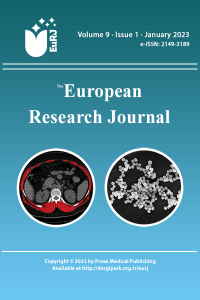Case Report
Year 2023,
Volume: 9 Issue: 1, 173 - 177, 04.01.2023
Abstract
References
- 1. Young WF. Clinical presentation and diagnosis of pheochromocytoma. 2022. https://www.uptodate.com/contents/clinical-presentation-and-diagnosis-of-pheochromocytoma. Accessed date: February 21, 2022.
- 2. Lenders JW, Eisenhofer G, Mannelli M, Pacak K. Phaeochromocytoma. Lancet 2005;366:665-75.
- 3. Linet MS, Ries LA, Smith MA, Tarone RE, Devesa VV. Cancer surveillance series: recenttrends in childhood cancer incidence and mortality in the United States. J Natl Cancer Inst 1999; 91:1051-8.
- 4. Bholah R, Bunchman TE. Review of pediatric pheochromocytoma and paraganglioma. Front Pediatr 2017;5:155.
- 5. Wyszyńska T, Cichocka E, Wieteska-Klimczak A, Januszewicz P. A single pediatric center experience with 1025 children with hypertension. Acta Paediatr 1992;81:244-6.
- 6. Barontini M, Levin G, Sanso G. Characteristics of pheochromocytoma in a 4- to 20-year-old population. Ann N Y Acad Sci 2006;1073:30-7.
- 7. Waguespack SG, Rich T, Grubbs E, Ying AK, Perrier ND, Ayala-Ramirez M, et al. A current review of the etiology, diagnosis, andtreatment of pediatric pheochromocytoma and paraganglioma. J Clin Endocrinol Metab 2010;95:2023-37.
- 8. Loosli N, Kohler BB, Pechere-Bertschi A, Karenovics W, Triponex F. Pheochromocytome et paragangliome: Que doit retenir le praticien? Rev Med Suisse 2014;10:1650-2.
- 9. Ilias I, Meristoudis G, Notopoulos A. A probabilistic assessment of the diagnosis of paraganglioma/pheochromocytoma based on clinical criteria and biochemical/imaging findings. Hell J Nucl Med 2015;18:63-5.
- 10. Gimenez-Roqueplo AP, Dahia PL, Robledo M. An update on thegenetics of paraganglioma, pheochromocytoma, and associated hereditary syndromes. Horm Metab Res 2012;44:328-33.
- 11. Molaei A, Abarzadeh-Bairami V, Sadat-Ebrahimi S-R. A case of pheochromocytoma presenting with cardiac manifestation: case report. BMC Pediatr 2020;20:299.
- 12. Beltsevich DG, Kuznetsov NS, Kazaryan AM, Lysenko MA. Pheochromocytoma surgery: epidemiologic peculiarities in children. World J Surg 2004;28:592-6.
- 13. Pham TH, Moir C, Thompson GB, Zarroug AE, Hamner CE, Farley D, et al. Pheochromocytoma and paraganglioma in children: a review of medical and surgical management at a tertiary care center. Pediatrics 2006;18:1109-17.
- 14. van der Zee PA, de Boer A. Pheochromocytoma: a review on preoperative treatment with phenoxybenzamine or doxazosin. Neth J Med 2014;72:190-201.
Year 2023,
Volume: 9 Issue: 1, 173 - 177, 04.01.2023
Abstract
Paragangliomas and pheochromocytomas are rare tumors originating in chromaffin cells which are predominantly located in adrenal glands. This tumor is generally bilateral and much more rarely seen in pediatric patients. Sustained or paroxysmal hypertension is the most frequent sign of paragangliomas /pheochromocytoma. Here, we present a 15-year-old patient diagnosed with the complaint of blurred vision.
References
- 1. Young WF. Clinical presentation and diagnosis of pheochromocytoma. 2022. https://www.uptodate.com/contents/clinical-presentation-and-diagnosis-of-pheochromocytoma. Accessed date: February 21, 2022.
- 2. Lenders JW, Eisenhofer G, Mannelli M, Pacak K. Phaeochromocytoma. Lancet 2005;366:665-75.
- 3. Linet MS, Ries LA, Smith MA, Tarone RE, Devesa VV. Cancer surveillance series: recenttrends in childhood cancer incidence and mortality in the United States. J Natl Cancer Inst 1999; 91:1051-8.
- 4. Bholah R, Bunchman TE. Review of pediatric pheochromocytoma and paraganglioma. Front Pediatr 2017;5:155.
- 5. Wyszyńska T, Cichocka E, Wieteska-Klimczak A, Januszewicz P. A single pediatric center experience with 1025 children with hypertension. Acta Paediatr 1992;81:244-6.
- 6. Barontini M, Levin G, Sanso G. Characteristics of pheochromocytoma in a 4- to 20-year-old population. Ann N Y Acad Sci 2006;1073:30-7.
- 7. Waguespack SG, Rich T, Grubbs E, Ying AK, Perrier ND, Ayala-Ramirez M, et al. A current review of the etiology, diagnosis, andtreatment of pediatric pheochromocytoma and paraganglioma. J Clin Endocrinol Metab 2010;95:2023-37.
- 8. Loosli N, Kohler BB, Pechere-Bertschi A, Karenovics W, Triponex F. Pheochromocytome et paragangliome: Que doit retenir le praticien? Rev Med Suisse 2014;10:1650-2.
- 9. Ilias I, Meristoudis G, Notopoulos A. A probabilistic assessment of the diagnosis of paraganglioma/pheochromocytoma based on clinical criteria and biochemical/imaging findings. Hell J Nucl Med 2015;18:63-5.
- 10. Gimenez-Roqueplo AP, Dahia PL, Robledo M. An update on thegenetics of paraganglioma, pheochromocytoma, and associated hereditary syndromes. Horm Metab Res 2012;44:328-33.
- 11. Molaei A, Abarzadeh-Bairami V, Sadat-Ebrahimi S-R. A case of pheochromocytoma presenting with cardiac manifestation: case report. BMC Pediatr 2020;20:299.
- 12. Beltsevich DG, Kuznetsov NS, Kazaryan AM, Lysenko MA. Pheochromocytoma surgery: epidemiologic peculiarities in children. World J Surg 2004;28:592-6.
- 13. Pham TH, Moir C, Thompson GB, Zarroug AE, Hamner CE, Farley D, et al. Pheochromocytoma and paraganglioma in children: a review of medical and surgical management at a tertiary care center. Pediatrics 2006;18:1109-17.
- 14. van der Zee PA, de Boer A. Pheochromocytoma: a review on preoperative treatment with phenoxybenzamine or doxazosin. Neth J Med 2014;72:190-201.
There are 14 citations in total.
Details
| Primary Language | English |
|---|---|
| Subjects | Paediatrics |
| Journal Section | Case Reports |
| Authors | |
| Publication Date | January 4, 2023 |
| Submission Date | November 11, 2021 |
| Acceptance Date | February 21, 2022 |
| Published in Issue | Year 2023 Volume: 9 Issue: 1 |
e-ISSN: 2149-3189
The European Research Journal, hosted by Turkish JournalPark ACADEMIC, is licensed under a Creative Commons Attribution-NonCommercial-NoDerivatives 4.0 International License.

2025


